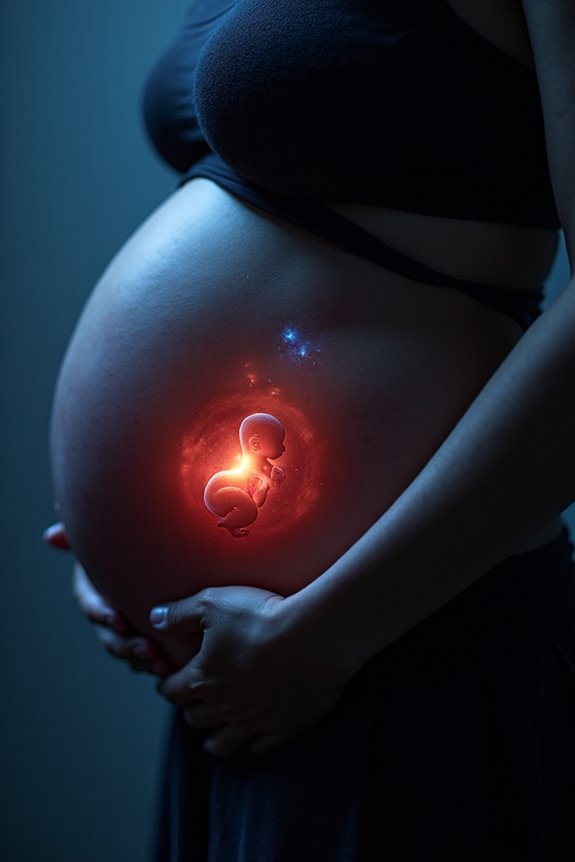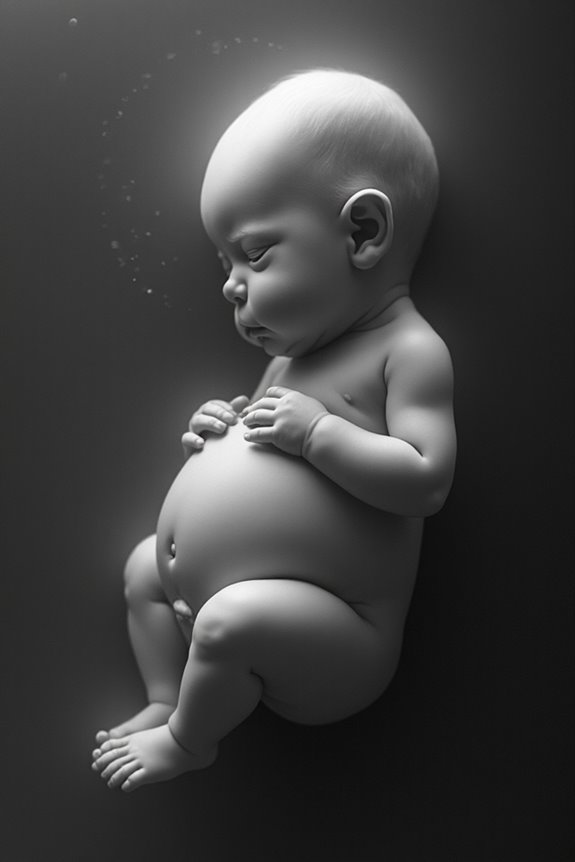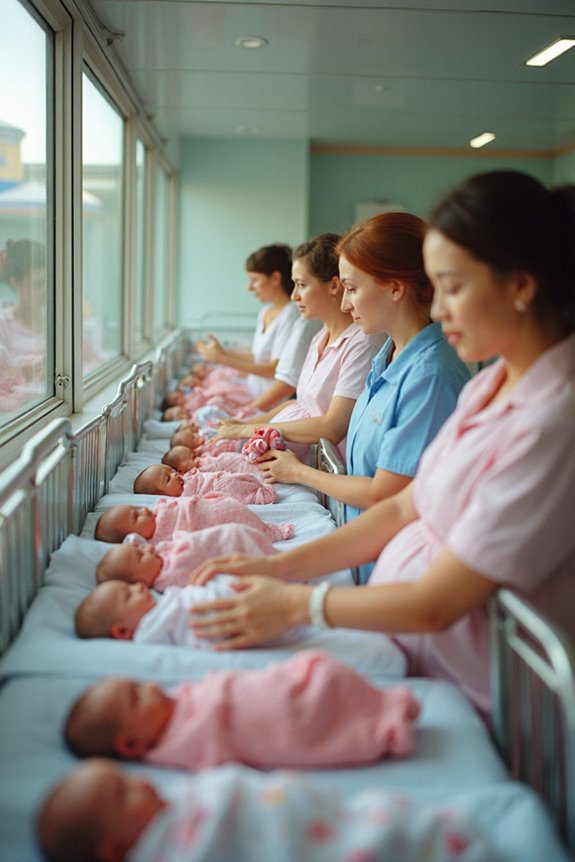A baby’s heartbeat begins developing around 21 days after fertilization, marking a crucial stage in fetal growth. By about 5-6 weeks, the fetal pole appears, and heartbeat detection is possible via transvaginal ultrasound. As we progress through pregnancy, methods like Doppler ultrasound provide easier monitoring. It’s essential to account for normal heart rate fluctuations, which usually range from 110 to 160 beats per minute. To learn more about fetal heart development, keep exploring the details ahead.
Key Takeaways
- A baby’s heartbeat begins around 21 days post-fertilization with the formation of the primitive heart tube.
- The heart starts beating at approximately 75-80 beats per minute by day 21.
- By 5-6 weeks, cardiac activity can be observed when the fetal pole becomes visible.
- Heartbeat detection is typically possible via transvaginal ultrasound between 6-7 weeks of pregnancy.
- Abdominal ultrasounds become effective for detecting the heartbeat around the 7-week mark.
The Development of the Fetal Heart
When we think about pregnancy, one of the most fascinating aspects is how the fetal heart develops. This remarkable process begins around 21 days post-fertilization, when the primitive heart tube forms through embryonic circulation. By the end of the third week, we see the heart tube looping and positioning itself in the thorax, creating an S shape.
Key points include:
- Heart Morphology: The heart tube consists of six segments, which will eventually turn into distinct chambers.
- Cardiac Activity: The heart starts beating around day 21, initially at 75-80 beats per minute.
- Development Stages: By the end of five weeks, major structures align similarly to an adult heart, ensuring it’s ready to support life.
Understanding this crucial development helps us appreciate the incredible journey of life.
Timeline of Heartbeat Detection

As the fetal heart develops, it’s fascinating to see how soon we can detect its activity. Around 5 weeks of gestation, the heart begins to pulse, and by 6 weeks, we can usually detect this heartbeat through transvaginal ultrasound. Here’s a timeline of what to expect:
- 5-6 weeks: The fetal pole becomes visible, indicating early cardiac activity.
- 6-7 weeks: A vaginal ultrasound can typically detect the heartbeat.
- 7 weeks: Abdominal ultrasounds become effective for heartbeat detection.
This early detection is crucial for monitoring fetal development, giving us insight into the heart’s formation. Understanding this timeline helps us connect with the miracle of life unfolding within, reinforcing the importance of regular check-ups during this exciting journey.
Methods for Detecting Cardiac Activity

Detecting a baby’s heartbeat during pregnancy is an essential part of prenatal care, allowing us to monitor the health and development of the fetus. Various detection methods help us hear that precious fetal heart sound.
- Transvaginal Ultrasound: This method can detect the fetal heart as early as 34 days post-conception.
- Transabdominal Ultrasound: More reliable after the first trimester, often paired with Doppler devices.
- Doppler Ultrasound Devices: These portable tools allow for easy monitoring of the fetal heart rate.
- Fetal Heart Rate Monitoring: Continuous electronic monitoring helps ensure the baby’s well-being.
Each method has its own benefits, helping us stay connected to our little one’s heartbeat as the pregnancy progresses.
Variations in Fetal Heart Rate

Variations in fetal heart rate provide us with valuable insights into the well-being of our developing baby. Understanding these changes is crucial for monitoring fetal health.
- Normal Range: The typical fetal heart rate ranges from 110 to 160 beats per minute.
- Heart Rate Variability: This variability can indicate how our baby is responding to different factors, including activity levels and maternal health.
- Gestational Age: As our pregnancy progresses, the heart rate stabilizes and shifts, reflecting growth.
Daily fluctuations are normal, influenced by factors like fetal movement and maternal nutrition. However, significant deviations from the normal range can signal potential issues. Keeping track of these changes helps us stay informed about our baby’s health journey. Regular check-ups with our healthcare provider can ensure everything is on track.
Stages of Pregnancy and Heartbeat

Monitoring our baby’s heartbeat is an exciting part of pregnancy that offers insight into their development. As we journey through the stages of pregnancy, we witness remarkable changes in fetal heart anatomy.
- Weeks 5-6: The heart begins to pulse, marking the start of embryonic circulation.
- Weeks 9-10: By now, the heart is fully formed, including essential structures like the aorta and pulmonary vein.
Initially, the heartbeat may be around 80-85 beats per minute, gradually increasing, peaking near 9 weeks. This growth is crucial, as a healthy heartbeat indicates our baby’s well-being. Monitoring these changes offers a comforting glimpse into their development, ensuring that our little one is thriving within us, fulfilling their growing needs for oxygen and nutrients.
The Role of Ultrasound Technology

Ultrasound technology plays a crucial role in our pregnancy journey, allowing us to connect with our baby in ways we never thought possible. With recent ultrasound advancements, we can detect our baby’s heartbeat as early as six weeks. This early detection reassures us of our little one’s health.
- Doppler Ultrasound: This non-invasive method provides real-time feedback on fetal heart activity, ensuring we stay informed.
- 3D and 4D Imaging: These techniques enhance our understanding of the fetal heart, making monitoring more engaging and detailed.
- Continuous Fetal Monitoring: We benefit from ongoing checks, which help in making timely decisions during our pregnancy.
Factors Influencing Heartbeat Detection

Understanding the various factors that influence heartbeat detection can be quite helpful as we navigate our pregnancy journey. It’s essential to consider several aspects:
- Maternal Health: Conditions like hypertension or diabetes can alter fetal heart rates.
- Fetal Position: The way our baby is positioned in the womb can make detection more difficult.
- Stress Levels: High stress can elevate the fetal heart rate due to hormonal changes.
- Hydration: Staying well-hydrated is vital, as dehydration can lead to heart rate fluctuations.
Other factors, like the quality of ultrasound equipment and the technician’s expertise, play a role too. By understanding these influences, we can feel more empowered during our prenatal visits, ensuring we’re informed and engaged in our baby’s development.
Frequently Asked Questions
Can Stress Affect the Fetal Heartbeat During Pregnancy?
Like a gentle breeze, we find that stress can ripple through a baby’s heartbeat. By embracing stress management techniques and regular fetal monitoring, we can help ensure that our little one’s rhythm remains steady and healthy.
What Are Abnormal Fetal Heart Rates to Watch For?
Let’s keep an eye on abnormal fetal heart rates, like persistent bradycardia or tachycardia. Using monitoring techniques, we can catch potential fetal arrhythmias early, ensuring our little one stays healthy throughout the pregnancy journey.
How Does Maternal Health Impact Fetal Heart Development?
We know that maternal health profoundly impacts fetal heart development. By focusing on maternal nutrition and proper prenatal care, we can nurture our baby’s heart, ensuring a healthier future for both our little one and ourselves.
Can Medications Influence the Fetal Heartbeat?
We understand that medications can influence heartbeat variations in our little ones. Certain medication types, like beta-blockers or stimulants, may alter fetal heart rates. It’s vital we consult our healthcare provider for guidance during pregnancy.
What Should I Do if I Can’t Hear the Heartbeat?
If we can’t hear the heartbeat, let’s consult our healthcare provider. They might recommend ultrasound techniques or heartbeat monitors for reassurance. Remember, it’s okay to seek support and stay informed during this journey together.





